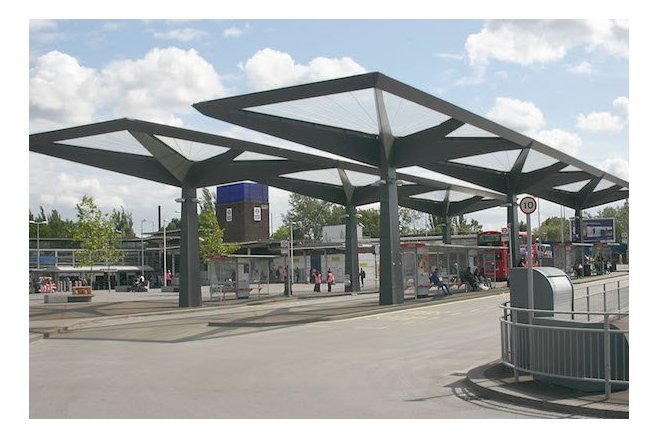ETFE FILM CANOPY FOR BUS STATION
General information
-
Home page
www.dyneon.eu
-
Location address
Tottenham, London
-
Location country
United Kingdom
-
Year of construction
2014
-
Name of the client/building owner
Transport for London
-
Function of building
Vehicle services
-
Degree of enclosure
Open structure
-
Climatic zone
Temperate - cold winters and mild summers
-
Number of layers
mono-layer
-
Type of application of the membrane
covering
-
Primary function of the tensile structure
- Daylight gains
- Rain protection
Description
Design
The key component of this project was the formation of a consolidated bus interchange, drawing together a plethora of bus stops and stands into a single location with safe, clear walking routes to the major rail interchange at Tottenham Hale. The main architectural challenge was to integrate this substantial piece of bus infrastructure in a characterful, elegant way that enhances, rather than distracts from the quality of public open space. In order to give the bus station a clear sense of place in an area dominated by non-descript, shed retail outlets and heavily traffic roads, Landolt + Brown architects and Mott MacDonald structural engineers developed proposals for a series of distinctive steel canopies which span the main waiting areas of the bus station. The brief for these structures, beyond providing shelter from the worst of the weather, was to minimise their physical impact on the (necessarily) narrow island waiting areas at street level, to ensure that they were of sufficient height to allow the buses to pass beneath them, with sufficient clearance to allow the buses to be jack-lifted in the event of breakdown and to create canopies that would allow daylight to penetrate, but would not be reliant on sheet materials that could collapse in the event of a vehicle fire or explosion.
Rows of steel trees support highly transparent film roof
Two rows of umbrellas with a total of around 860m² of film roof protect passengers against rain and snow. The highly transparent films made of Dyneon ETFE allow more than 95% of the light to pass through, but weigh only 5% of a comparable glass construction. The support structures for the film roofs are thus very slender, which further increases the brightness. Each row of umbrellas consists of three steel columns. Six arms radiate from each in a star pattern, ending in a rectangular frame measuring 8mx17m. The construction is deliberately designed to resemble a row of trees. Vector Foiltec GmbH has stretched single-layer ETFE film between the struts. Tensioning wires support the film webs, which are welded to each other. Vector Foiltec covers the entire spectrum from the conception to the support structure planning and from the manufacturing
to the installation of the film roofs. Multi-layer pneumatically supported film cushions are often used for closed buildings. They offer good insulation against outside temperatures and sustainably lower air conditioning and heating costs. A single-layer version is sufficient for open-air applications.
Resistant to dirt of all kinds
The films were extruded from 3M Dyneon ETFE by Nowofol Kunststoffprodukte GmbH & Co. KG. The company produces NOWOFLON® ET 6235Z films in thicknesses of between 80 and 400 microns. Transparent films have been used in London, but Nowofol produces them in virtually all RAL colours for other applications.
Resistant to chemicals of all kinds
The steelwork is designed for a lifetime of 60 years and will most probably last well beyond Tottenham Hale's 200th birthday. That also applies to the films made from Dyneon ETFE. They have proven to be extremely robust and durable for over forty years in all climate zones. There are no discolourations whatsoever, even after decades of intense solar irradiation.
Dyneon ETFE is chemically resistant to virtually all other compounds – animportant prerequisite for use in urban agglomerations with their numerous emissions and types of dirt. The umbrellas are shaped like upside down pyramids. As a result, the typical English heavy rain is discharged through the hollow central columns into the sewer. The surface of the film is so smooth that the rain showers rinse off virtually all dirt particles. The roof is thus practically maintenance free. ETFE films feature very good values for tensile strength, tear propagation resistance and puncture resistance. They also reliably withstand impact- type loads, such as those caused by hail, and can bear high snow loads. Not only that, they meet the high requirements for fire protection with fire class B1 (according to DIN 4102).
Description of the environmental conditions
Material of the cover
-
Cable-net/Fabric/Hybrid/Foil
Foil
-
Type (code)
NOWOFLON® ET 6235Z
Main dimensions and form
-
Covered surface (m2)
720
-
Form single element
Flat appearance
Duration of use
-
Temporary or permanent structure
Permanent
Involved companies
-
Architects
Landolt + Brown Architects
-
Engineers
Mott MacDonald
-
Contractors
Vector Foiltec GmbH
-
Suppliers
NOWOFOL
Editor
-
Editor
Evi Corne


